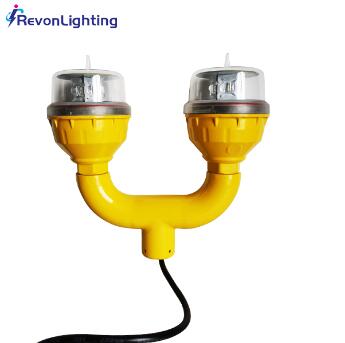Obstacle lights are an integral component of aviation safety, serving as crucial visual aids to warn pilots of potential obstructions in their flight path. This article delves into the significance, types, regulations, and advancements in obstacle lights, highlighting their pivotal role in ensuring safe air navigation.
Importance of Obstacle Lights in Aviation Safety
Obstacle lights are essential for alerting pilots to the presence of tall structures, such as buildings, towers, and wind turbines, which could pose hazards during aircraft take-off, landing, and low-altitude flights. These lights enable pilots to identify and avoid obstacles, significantly reducing the risk of accidents and ensuring safe operations in both day and night conditions.

Types of Obstacle Lights
a) Red Obstruction Lights: Red lights are the most commonly used type of obstacle lights in aviation. They are employed to indicate the presence of an obstruction and typically flash to enhance visibility, especially during low-visibility conditions.
b) White Obstruction Lights: White lights are utilized to mark structures such as telecommunication towers, where red lights could cause confusion with aircraft warning lights. These lights help in delineating the outline of the structure without interfering with aviation safety.
Regulatory Standards and Compliance
Aviation authorities, such as the Federal Aviation Administration (FAA) in the United States and the International Civil Aviation Organization (ICAO) globally, have established regulations and standards for obstacle lighting to ensure uniformity and effectiveness. These regulations outline the specifications for light intensity, flash characteristics, and placement, contributing to standardized safety practices across aviation infrastructure.
Advancements in Obstacle Lighting Technology
a) LED Technology: Light Emitting Diode (LED) lights have replaced traditional incandescent lights in many aviation applications due to their energy efficiency, long lifespan, and ability to produce bright, high-visibility illumination.
b) Solar-Powered Obstacle Lights: Solar-powered lights have gained popularity for their sustainable and cost-effective operation. By harnessing solar energy, these lights reduce reliance on traditional power sources and lower overall operational costs.
Implementation and Impact
Obstacle lights are not only crucial for tall man-made structures but also serve as essential aids for marking natural obstacles, such as hills and mountains, in the vicinity of airports. The implementation of these lights has significantly contributed to reducing the number of aviation accidents and near-misses associated with obstructions.
| 1 | obstacle lights aviation |
| 2 | obstacle lights aviation |
| 3 | 4 |
Future Trends and Considerations
Advancements in technology, including the integration of smart lighting systems and the use of unmanned aerial vehicles (UAVs) for inspection and maintenance, are poised to further enhance the effectiveness and reliability of obstacle lights. Additionally, continued research and innovation in lighting materials and design will contribute to improved visibility and sustainability of obstacle lighting systems.
Conclusion:
Obstacle lights aviation play a critical role in ensuring the safety of air navigation by providing clear visual cues to pilots and contributing to the prevention of mid-air collisions and accidents. With ongoing technological advancements and stringent regulatory standards, the aviation industry continues to prioritize the implementation of effective obstacle lighting systems to uphold the highest standards of safety and operational excellence.